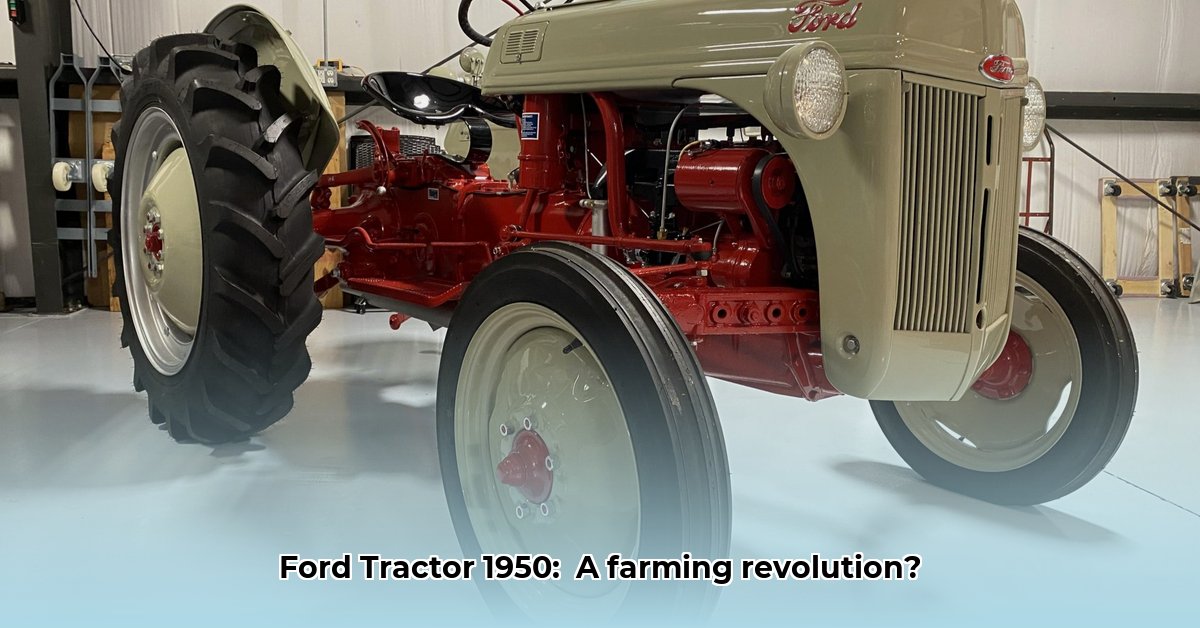
The iconic Ford 9N tractor, though not launched in 1950, profoundly impacted agriculture, leaving a legacy that intertwines with the modern pursuit of sustainable farming practices. This article explores the complex relationship between this classic machine, its influence on agricultural methods, and its surprising relevance to today's environmentally conscious farmers. We'll examine the 9N's transformative role, its enduring appeal, and the ongoing debate surrounding its environmental footprint. For more on early Ford tractors, see this 1952 Ford 8N resource.
The 9N's Revolution and its Unforeseen Consequences
Introduced in 1939, the Ford 9N tractor irrevocably altered the agricultural landscape. Farmers, previously reliant on animal power, experienced a dramatic increase in efficiency and productivity. This mechanization boosted crop yields, playing a crucial role in feeding a rapidly growing global population. However, this efficiency wasn't without its drawbacks. The 9N's widespread adoption contributed to the rise of large-scale, monoculture farming—a practice that, while maximizing output, significantly depleted soil health and biodiversity. This raises a critical question: did the short-term gains in food production outweigh the long-term environmental costs? The answer, as we'll explore, is complex and multifaceted.
"The 9N's impact is a double-edged sword," explains Dr. Emily Carter, Agricultural Historian at the University of California, Berkeley. "While it undeniably increased food production, its contribution to unsustainable monoculture farming practices is undeniable." This multifaceted impact necessitates a nuanced analysis going beyond simple praise or condemnation.
This increased efficiency, a quantifiable fact supported by historical yield data, led to a dramatic shift in farming practices. But how did this efficiency translate into long-term sustainability? This is a crucial question that the article investigates further.
The Rise, Fall, and Resurgence of Ford in Agriculture
Ford's role in agricultural machinery is a complex narrative of innovation, consolidation, and unexpected revival. The company built on the 9N's success, introducing ever-more sophisticated models. However, the 1985 merger with New Holland, followed by the sale of its agricultural equipment division to Fiat, marked significant turning points. While these mergers resulted in technological advancements and economies of scale, they also raised concerns about reduced competition and the potential prioritization of short-term profits over long-term sustainability. Did this consolidation inadvertently hinder the development of more environmentally friendly technologies? This remains a topic of ongoing discussion and research among agricultural economists.
This consolidation, a key event in the history of agricultural machinery, raises concerns about the long-term consequences of prioritizing corporate mergers over sustainable innovation. What were the unintended environmental consequences?
The Unexpected Second Life of Vintage Ford Tractors
Surprisingly, vintage Ford tractors, including models from the 1950s, are experiencing a resurgence in popularity. These machines, readily available at various price points, are not simply nostalgic relics. Their robust design and durability—many remain functional decades later—make them ideally suited for smaller-scale, sustainable farming operations. This renewed interest aligns with current efforts towards creating a more environmentally conscious agricultural sector. Restoring and utilizing these older tractors promotes a circular economy and presents a viable alternative to fuel-intensive modern equipment. This trend also promotes community engagement in skills-sharing and parts restoration.
This renewed interest in vintage machines is particularly noteworthy because it underscores the connection between sustainability and a respect for longevity in design. But how can we ensure this renewed interest is truly environmentally sound?
Unanswered Questions and the Need for Further Research
While the legacy of the Ford 9N and its successors is undeniably linked to increased agricultural production, a thorough understanding of their environmental impact requires further investigation. Detailed data on fuel efficiency, emissions, and overall lifecycle analysis (from manufacturing to disposal) remains scarce. Ongoing research is crucial to fully quantify the environmental footprint of different Ford tractor models and their associated farming practices. This includes assessing the impacts on soil health, water usage, and greenhouse gas emissions. The need for comprehensive data is evident, emphasizing the importance of continued research in this area.
This lack of data highlights a critical need for more research, highlighting the ongoing efforts to assess and quantify these machines' effects. How can we better understand the full environmental impact?
A Legacy for the Future: Collaboration is Essential
Collaborations are needed across various stakeholders to create a truly sustainable agricultural future. By considering short-term actions and fostering long-term goals, a collaborative approach among vintage tractor owners, agricultural historians, equipment manufacturers, farmers, and policy makers is crucial. Through this multi-faceted approach, a more sustainable future can be achieved.